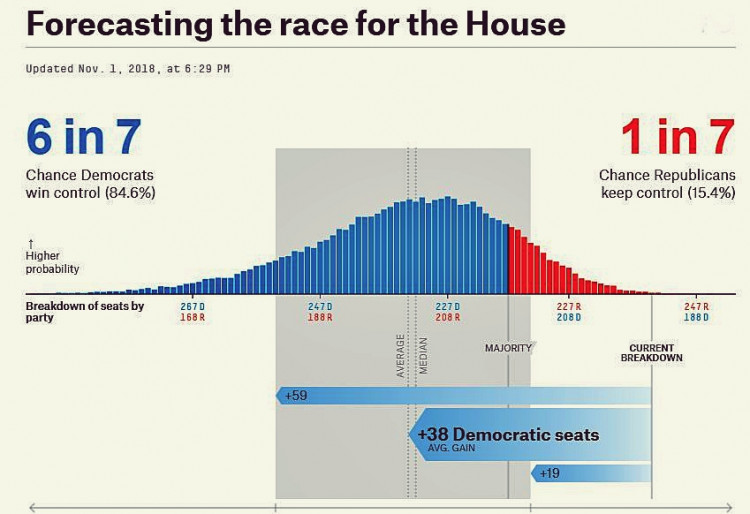The Democratic Party "Blue Wave" will engulf the U.S. House of Representatives in the U.S. midterm elections only four days from now (Nov. 6), and bring the Democrats to a position where it can hold president Donald Trump accountable for his actions.
The question now is whether this tsunami of liberalism created by discontent and anger over Trump's divisive and right-wing (some say racist) America first politics and irrational presidential actions will swamp the U.S. Senate, as well.
Democrats are confident of victory in the House. House Minority Leader Nancy Pelosi (D-CA) a few days ago went so far as to predict, "Let me say this. Up until today, I would've said, 'If the election were held today, we would win.' ... What I'm saying now is, 'We will win!'"
As it was two months ago, polls by most respected U.S. public opinion survey firms point to the Democrats winning the House on Nov. 6. In U.S. politics, the party in power (in this case Trump's Republican Party) generally loses the midterms. This was the case with former presidents Barack Obama and George Bush.
This phenomenon has been traced to traditionally low voter turnout (midterms aren't as consequential as presidential elections), and the desire of the American electorate to not have one party remain in total control of the U.S. Congress for four full years. It's a kind of voter inspired checks and balances.
Polls indicate the same story in the midterms. And top Republican strategists told the media they've given up their campaign to retain Republican control of the House.
All 435 seats in the House are up for grabs in the midterms, as well as 35 seats in the Senate, and 39 governorships.
The Republican Party or the GOP currently controls the Senate and House of Representatives, but failed to hold on to either will cause political deadlock for Trump's most radical policies. Trump's impeachment is certainly in the cards when Democrats retake the House and will be a certainty if they seize the Senate, as well.
Democrats only need to win 23 seats to take the House. A poll by CNN rates 49 as contested. Of this total, 30 seats as either toss-up; leaning toward Democrats (14) or likely to go for Democrats (5). Of the 49, Republicans currently, hold 42 (including 29 toss-up seats); 10 lean Democratic and 3 likely Democratic.
Analysts said Democrats are more than halfway to winning back the House if they win only those Republican seats that are solid, leaning or likely to go for them. The Democrats will win 28 seats if they win GOP seats leaning or likely to go for them while splitting the Republican toss-up races down the middle (14 for Democrats, 15 for the GOP).
Many of the likeliest Democratic wins in the House will come from Republican seats vacated by either retirements or members running for higher office. There are about 40 open GOP seats, which is a record, and many are in areas now vulnerable to the Democrats. These districts are either swing districts or slightly tilted to the GOP.
The path to victory is easier for Democrats. Pollsters note the Democrats' upside remains very high while the party's downside is almost non-existent. And Democrats might only lose three seats in the House, and these three are rated as toss-ups in comparison to 29 Republican toss-ups.





